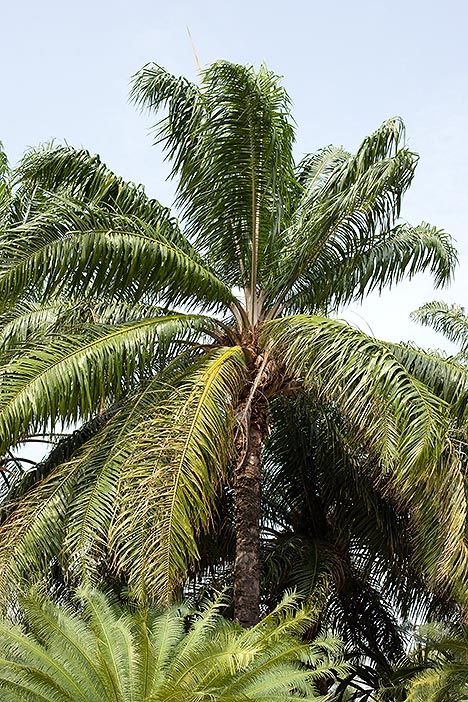Family : Arecaceae

Text © Pietro Puccio

English translation by Mario Beltramini

The Elaeis guineensis is much cultivated in tropics for the production of oil © Giuseppe Mazza
The Elaeis guineensis Jacq. (1763) is native to tropical Africa (Angola, Benin, Burkina Faso, Burundi, Cameroon, Congo, Ivory Coast, Gabon, Ghana, Guinea, Kenya, Liberia, Malawi, Nigeria, Central African Republic, Rwanda, Senegal, Sierra Leone, Tanzania, Togo, Uganda, Zaire), where it grows at the margins of the pluvial forests and along the courses of water.
The name of the genus comes from the Greek “élaion”= oil, the name of the species refers to one of its countries of origin.
The most used common names are: “palma da olio” (Italian); “African oil palm”, “macaw fat”, “oil palm”, “palm kernel oil” (English); “palmier à huile”, “palmier à huile d’Afrique” (French); Afrikanische Ölpalme”, “Ölpalme” (German); “corojo de Guinea”, “palmera de aceite” (Spanish); “caiaué”, “dendezeiro”, “palmeira dendém”, “palmeira andim” (Portuguese); “mchikichi”, “miwesi”, “mjen- ga” (Swahili).
It shows a solitary trunk tall up to 20 metres and with a diameter of about 40 cm, with the foliar bases persisting for long time on the younger part. The crown, thick and impressive, is formed by pinnate leaves, curved on the terminal part, four metres long, which persist for long time; the pinnulae, of a glossy green colour, are long up to about 70 cm and are inserted with various angles on the rachis; the petiole, thickly fibrous on the base, is provided with short triangular thorns on the margins.
Monoecious plant, it develops separate, but on the same plant, male and female inflorescences between the leaves, compact and long up to about 30 cm. The fructification is abundant and continuous all over the year; the fruits are ovoid, long about 4 cm, usually of a blackish colour, and orange-red at the base. It reproduces by seed, which germinates in 6-8 months, if opportunely previously treated and and with bottom heat.
The cultivation of this plant for the oil production, has had during the very last years a remarkable increase, such as to overcome any other vegetable source. This is due to the copious and uninterrupted fructification and the high percentage of oil present in the pulp (up to the 65%) and in the endosperm (up to the 50%). The refined oil palm and its by-products are widely utilized not only in the alimentary field and in the making of products for the personal hygiene (soaps, cleansing agents, etc.), but also in countless and varied industrial products. Finally, it is already utilized, and a further increase is expected, as fuel (biodiesel).
The plant has also a moderate utilization as ornament, limited to the tropical and warm-humid subtropical climate, as they do not bear temperatures even if just close to 0 °C.
Synonyms: Elaeis guineensis subsp. nigrescens A.Chev. (1910); Elaeis nigrescens (A.Chev.) Prain, (1913); Palma oleosa Mill. (1768); Elaeis melanococca Gaertn. (1788); Elaeis melanococca var. semicircularis Oerst. (1859); Elaeis dybowskii Hua (1895); Elaeis guineensis f. androgyna A.Chev. (1910); Elaeis guineensis var. ceredia A.Chev. (1910); Elaeis guineensis f. dioica A.Chev. (1910); Elaeis guineensis var. gracilinux A.Chev. (1910); Elaeis guineensis var. idolatrica A.Chev. (1910); Elaeis guineensis var. intermedia A.Chev. (1910); Elaeis guineensis var. macrocarpa A.Chev. (1910); Elaeis guineensis var. macrophylla A.Chev. (1910); Elaeis guineensis var. pisifera A.Chev. (1910); Elaeis guineensis f. ramosa A.Chev. (1910); Elaeis guineensis var. repanda A.Chev. (1910); Elaeis guineensis var. sempernigra A.Chev. (1910); Elaeis guineensis var. spectabilis A.Chev. (1910); Elaeis guineensis subsp. virescens A.Chev. (1910); Elaeis guineensis var. madagascariensis Jum. & H.Perrier (1911); Elaeis virescens (A.Chev.) Prain (1913); Elaeis guineensis var. albescens Becc. (1914); Elaeis guineensis var. angulosa Becc. (1914); Elaeis guineensis f. caryolitica Becc. (1914); Elaeis guineensis var. compressa Becc. (1914); Elaeis guineensis f. dura Becc. (1914); Elaeis guineensis f. fatua Becc. (1914); Elaeis guineensis var. leucocarpa Becc. (1914); Elaeis guineensis var. macrocarya Becc. (1914); Elaeis guineensis var. rostrata Becc. (1914); Elaeis guineensis f. semidura Becc. (1914); Elaeis guineensis f. tenera Becc. (1914); Elaeis madagascariensis (Jum. & H.Perrier) Becc. (1914); Elaeis macrophylla A.Chev. (1920).
→ For general notions about ARECACEAE please click here.
